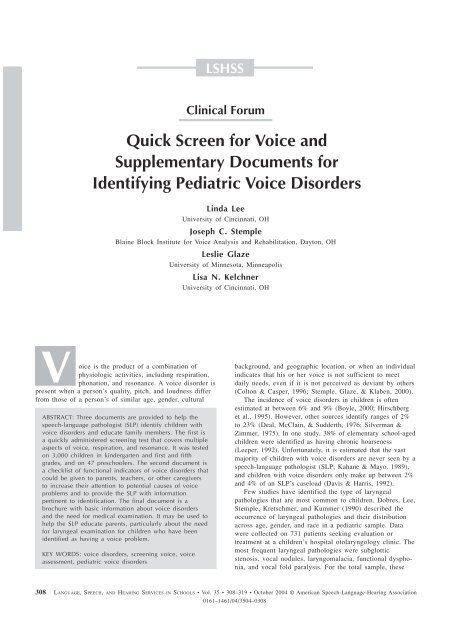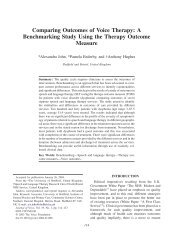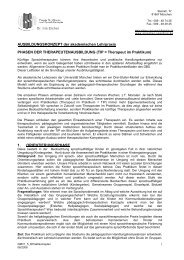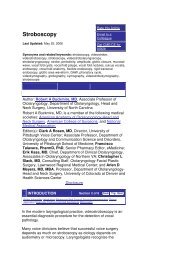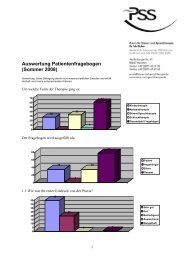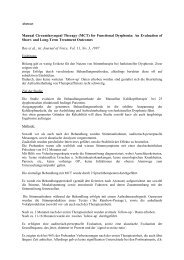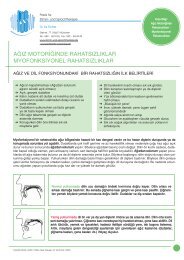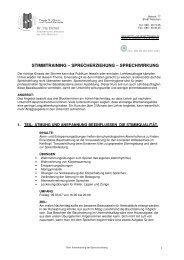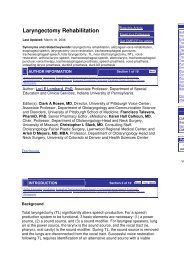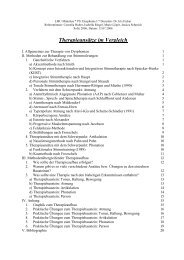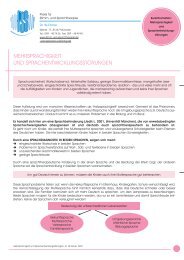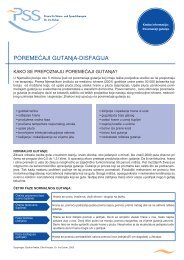Quick Screen for Voice 1 - Stimm-und-sprachtherapie.de
Quick Screen for Voice 1 - Stimm-und-sprachtherapie.de
Quick Screen for Voice 1 - Stimm-und-sprachtherapie.de
You also want an ePaper? Increase the reach of your titles
YUMPU automatically turns print PDFs into web optimized ePapers that Google loves.
LSHSS<br />
Clinical Forum<br />
<strong>Quick</strong> <strong>Screen</strong> <strong>for</strong> <strong>Voice</strong> and<br />
Supplementary Documents <strong>for</strong><br />
I<strong>de</strong>ntifying Pediatric <strong>Voice</strong> Disor<strong>de</strong>rs<br />
Linda Lee<br />
University of Cincinnati, OH<br />
Joseph C. Stemple<br />
Blaine Block Institute <strong>for</strong> <strong>Voice</strong> Analysis and Rehabilitation, Dayton, OH<br />
Leslie Glaze<br />
University of Minnesota, Minneapolis<br />
Lisa N. Kelchner<br />
University of Cincinnati, OH<br />
V<br />
oice is the product of a combination of<br />
physiologic activities, including respiration,<br />
phonation, and resonance. A voice disor<strong>de</strong>r is<br />
present when a person’s quality, pitch, and loudness differ<br />
from those of a person’s of similar age, gen<strong>de</strong>r, cultural<br />
ABSTRACT: Three documents are provi<strong>de</strong>d to help the<br />
speech-language pathologist (SLP) i<strong>de</strong>ntify children with<br />
voice disor<strong>de</strong>rs and educate family members. The first is<br />
a quickly administered screening test that covers multiple<br />
aspects of voice, respiration, and resonance. It was tested<br />
on 3,000 children in kin<strong>de</strong>rgarten and first and fifth<br />
gra<strong>de</strong>s, and on 47 preschoolers. The second document is<br />
a checklist of functional indicators of voice disor<strong>de</strong>rs that<br />
could be given to parents, teachers, or other caregivers<br />
to increase their attention to potential causes of voice<br />
problems and to provi<strong>de</strong> the SLP with in<strong>for</strong>mation<br />
pertinent to i<strong>de</strong>ntification. The final document is a<br />
brochure with basic in<strong>for</strong>mation about voice disor<strong>de</strong>rs<br />
and the need <strong>for</strong> medical examination. It may be used to<br />
help the SLP educate parents, particularly about the need<br />
<strong>for</strong> laryngeal examination <strong>for</strong> children who have been<br />
i<strong>de</strong>ntified as having a voice problem.<br />
KEY WORDS: voice disor<strong>de</strong>rs, screening voice, voice<br />
assessment, pediatric voice disor<strong>de</strong>rs<br />
backgro<strong>und</strong>, and geographic location, or when an individual<br />
indicates that his or her voice is not sufficient to meet<br />
daily needs, even if it is not perceived as <strong>de</strong>viant by others<br />
(Colton & Casper, 1996; Stemple, Glaze, & Klaben, 2000).<br />
The inci<strong>de</strong>nce of voice disor<strong>de</strong>rs in children is often<br />
estimated at between 6% and 9% (Boyle, 2000; Hirschberg<br />
et al., 1995). However, other sources i<strong>de</strong>ntify ranges of 2%<br />
to 23% (Deal, McClain, & Sud<strong>de</strong>rth, 1976; Silverman &<br />
Zimmer, 1975). In one study, 38% of elementary school-aged<br />
children were i<strong>de</strong>ntified as having chronic hoarseness<br />
(Leeper, 1992). Un<strong>for</strong>tunately, it is estimated that the vast<br />
majority of children with voice disor<strong>de</strong>rs are never seen by a<br />
speech-language pathologist (SLP; Kahane & Mayo, 1989),<br />
and children with voice disor<strong>de</strong>rs only make up between 2%<br />
and 4% of an SLP’s caseload (Davis & Harris, 1992).<br />
Few studies have i<strong>de</strong>ntified the type of laryngeal<br />
pathologies that are most common to children. Dobres, Lee,<br />
Stemple, Kretschmer, and Kummer (1990) <strong>de</strong>scribed the<br />
occurrence of laryngeal pathologies and their distribution<br />
across age, gen<strong>de</strong>r, and race in a pediatric sample. Data<br />
were collected on 731 patients seeking evaluation or<br />
treatment at a children’s hospital otolaryngology clinic. The<br />
most frequent laryngeal pathologies were subglottic<br />
stenosis, vocal nodules, laryngomalacia, functional dysphonia,<br />
and vocal fold paralysis. For the total sample, these<br />
308 LANGUAGE, SPEECH, AND AND HEARING HEARING SERVICES SERVICES IN SCHOOLS IN SCHOOLS • Vol. 35 • 308–319 Vol. 35 • October • 308–319 2004 © • American October Speech-Language-Hearing 2004<br />
Association<br />
0161–1461/04/3504–0308
pathologies were much more common in males than in<br />
females, with the youngest patients (less than 6 years old)<br />
i<strong>de</strong>ntified as having the most pathologies. The distribution<br />
of pathologies within the races sampled (Caucasian, African<br />
American, and Asian) was similar to that fo<strong>und</strong> throughout<br />
the total sample.<br />
Although it has been argued by some that treating voice<br />
disor<strong>de</strong>rs in children is unnecessary or even potentially<br />
harmful (Batza, 1970; San<strong>de</strong>r, 1989), others have argued<br />
<strong>for</strong> the opposite opinion (Kahane & Mayo, 1989; Miller &<br />
Madison, 1984). In<strong>de</strong>ed, Andrews (1991) suggested that<br />
unlike some other <strong>de</strong>velopmental disor<strong>de</strong>rs, maturation<br />
alone does not significantly affect vocal symptoms.<br />
Habitual patterns of poor voice use do not, as some have<br />
suggested, disappear at puberty. In other words, children do<br />
not outgrow voice disor<strong>de</strong>rs.<br />
The i<strong>de</strong>ntification and management of pediatric voice<br />
disor<strong>de</strong>rs is important <strong>for</strong> the child’s educational and<br />
psychosocial <strong>de</strong>velopment, as well as physical and emotional<br />
health. The <strong>und</strong>erlying cause of any dysphonia must<br />
be <strong>de</strong>termined because voice disor<strong>de</strong>rs that share the same<br />
quality <strong>de</strong>viations may have vastly different behavioral,<br />
medical, or psychosocial etiologies (see review in Stemple<br />
et al., 2000).<br />
The majority of children with voice problems are<br />
i<strong>de</strong>ntified by individuals other than the school SLP (Davis<br />
& Harris, 1992). Typically, the teacher, nurse, or a family<br />
member notices that a child has <strong>de</strong>veloped an abnormal<br />
voice quality and makes the initial contact with the SLP.<br />
These referral sources lack training in making perceptual<br />
quality judgments, so they may miss more subtle problems<br />
that need professional attention. Depending on the task,<br />
teachers may or may not be accurate in i<strong>de</strong>ntifying children<br />
with voice <strong>de</strong>viations (see review in Davis & Harris, 1992),<br />
and many parents may assume that the child will outgrow<br />
the disor<strong>de</strong>r. Perceptual voice quality evaluation can be<br />
difficult even <strong>for</strong> the SLP (Kreiman, Gerratt, Kempster,<br />
Erman, & Berke, 1993; Kreiman, Gerratt, Precoda, &<br />
Berke, 1992), so <strong>de</strong>pending on untrained persons to i<strong>de</strong>ntify<br />
these children is less than i<strong>de</strong>al.<br />
One common method of i<strong>de</strong>ntifying childhood communication<br />
disor<strong>de</strong>rs is through mass screening. Un<strong>for</strong>tunately,<br />
voice has received scant attention in most speech and<br />
language screening tools. For example, the Fluharty-2<br />
Preschool Speech and Language <strong>Screen</strong>ing Test (Fluharty,<br />
2001) has one line <strong>for</strong> clinician response to voice quality<br />
(“so<strong>und</strong>ed normal; recheck may be necessary”). Similarly,<br />
one line <strong>for</strong> <strong>de</strong>scription of the voice is allotted on the<br />
Speech-Ease <strong>Screen</strong>ing Inventory (Pigott et al., 1985).<br />
These conventional one-line summaries fail to address the<br />
voice comprehensively; that is, they do not assess the three<br />
subsystems of respiration, phonation, and resonance. <strong>Voice</strong><br />
problems are typically reduced to a generic <strong>de</strong>scription of<br />
quality <strong>de</strong>viation and may easily be overlooked because of<br />
such minimal opportunity <strong>for</strong> evaluation.<br />
I<strong>de</strong>ntification of children with voice disor<strong>de</strong>rs could be<br />
facilitated with several documents. A screening tool<br />
covering multiple aspects of voice, respiration, and resonance<br />
could replace the more general voice evaluation<br />
statements that are provi<strong>de</strong>d on current screening tools.<br />
Additionally, a checklist of functional indicators of voice<br />
disor<strong>de</strong>rs in children and adolescents that could be given to<br />
parents, teachers, or other caregivers may increase their<br />
attention to potential causes of voice problems and provi<strong>de</strong><br />
the SLP with in<strong>for</strong>mation pertinent to i<strong>de</strong>ntification. Finally,<br />
a brochure with basic in<strong>for</strong>mation about voice disor<strong>de</strong>rs and<br />
the need <strong>for</strong> medical examination may help the SLP<br />
educate parents. These needs are addressed in the present<br />
document.<br />
QUICK SCREEN FOR VOICE<br />
A screening tool entitled <strong>Quick</strong> <strong>Screen</strong> <strong>for</strong> <strong>Voice</strong> (see<br />
Appendix A) was <strong>de</strong>veloped by the second author (JS). It<br />
provi<strong>de</strong>s more thorough <strong>de</strong>lineation of tasks and measures<br />
than the more open-en<strong>de</strong>d requests <strong>for</strong> observation of voice<br />
quality that are currently available on speech and language<br />
screening tests. The tool may be used <strong>for</strong> speakers of all<br />
ages, from preschool through adult.<br />
Respiration, phonation, resonance, and vocal flexibility<br />
are the hallmarks of healthy and acceptable voice production,<br />
and all are inclu<strong>de</strong>d in this test. These subsystems of voice<br />
production are assessed separately. Lists of perceptual<br />
characteristics that are commonly associated with disor<strong>de</strong>rs<br />
of that subsystem are contained in each section. Definitions<br />
of each perceptual characteristic are provi<strong>de</strong>d in Appendix B.<br />
The protocol is <strong>de</strong>signed to be administered in 5 to 10<br />
min. Administration time is reduced when the child’s voice<br />
is judged to be normal. When abnormal signs are fo<strong>und</strong> in<br />
any subsection, the test <strong>for</strong>m provi<strong>de</strong>s appropriate language<br />
<strong>for</strong> vocal behaviors that the SLP may not observe or<br />
i<strong>de</strong>ntify without it. These i<strong>de</strong>ntifiers can then be used when<br />
reporting findings and generating individualized educational<br />
plan (IEP) goals, if a management program is necessary.<br />
Directions and Scoring<br />
The <strong>Quick</strong> <strong>Screen</strong> <strong>for</strong> <strong>Voice</strong> should be administered in a<br />
quiet area that is free of distractions. The tester should be<br />
seated close to the individual.<br />
Perceptual characteristics of the voice are judged by<br />
listening to the individual speak. There<strong>for</strong>e, the examiner<br />
should engage the individual in topics, such as family or<br />
friends, hobbies or other interests, favorite holidays or<br />
vacations, favorite classes in school, and so on. To assist<br />
elicitation of spontaneous speech, the individual may be<br />
asked to tell a story about pictures that are sufficiently<br />
<strong>de</strong>tailed to allow a 2–3 min <strong>de</strong>scription or elicited sample.<br />
Recited passages, counting, or other natural samples of<br />
continuous speech may also be used.<br />
The examiner responds to a checklist of observations that<br />
are ma<strong>de</strong> during the spontaneous speech and other voicing<br />
tasks. The speaker fails the screening test if one or more<br />
disor<strong>de</strong>rs in production are fo<strong>und</strong> in any section. In such<br />
cases, the individual would be scheduled to be screened<br />
again, have a more comprehensive voice evaluation, or be<br />
referred to a physician with a request that the child be<br />
examined by an otolaryngologist or other specialist.<br />
Lee et al.: <strong>Quick</strong> <strong>Screen</strong> <strong>for</strong> <strong>Voice</strong> 309
Field Tests and Subsequent Revisions<br />
The screening tool was used during two <strong>for</strong>mal mass<br />
speech and language screenings with preschool and schoolage<br />
children, and more in<strong>for</strong>mally with adult graduate<br />
stu<strong>de</strong>nts taking a voice disor<strong>de</strong>rs class. The primary purpose<br />
of using the tool in these situations was to <strong>de</strong>termine its ease<br />
and clarity of use, whether or not it contained complete lists<br />
of observations <strong>und</strong>er each category, and confirmation of the<br />
criterion <strong>for</strong> passing or failing.<br />
<strong>Screen</strong>ing of kin<strong>de</strong>rgarten and first and fifth gra<strong>de</strong><br />
stu<strong>de</strong>nts. The <strong>Quick</strong> <strong>Screen</strong> <strong>for</strong> <strong>Voice</strong> was used as part of a<br />
comprehensive speech, language, and hearing screening of<br />
3,000 elementary school children in 53 school districts<br />
throughout Ohio. Half of the children were in regular<br />
kin<strong>de</strong>rgarten and first gra<strong>de</strong>; half were in fifth gra<strong>de</strong>. The<br />
school districts were chosen because they represented a wi<strong>de</strong><br />
variety of urban, rural, and suburban locations; average<br />
family income; percentage of minority population; and<br />
district expenditure per pupil. Stu<strong>de</strong>nts receiving part-time<br />
special education services were inclu<strong>de</strong>d. Stu<strong>de</strong>nts receiving<br />
full-time special education in segregated classes or separate<br />
buildings were omitted from the sample. Seven university<br />
<strong>de</strong>partments participated. The screening tests were administered<br />
by trained graduate stu<strong>de</strong>nts <strong>und</strong>er the supervision of<br />
licensed and certified SLPs. The stu<strong>de</strong>nts practiced administering<br />
the tests be<strong>for</strong>e conducting the screening.<br />
The percentage of stu<strong>de</strong>nts failing the total screening<br />
test and each subcategory is contained in Table 1. Some<br />
individuals who fail screening tests will be fo<strong>und</strong> by more<br />
intensive diagnostic tests not to have a communication<br />
disor<strong>de</strong>r (i.e., a false positive). Conversely, some stu<strong>de</strong>nts<br />
with a communication disor<strong>de</strong>r may pass a screening,<br />
although the inci<strong>de</strong>nce of these false negatives is expected<br />
to be low if examiners are trained and tests are properly<br />
administered. The actual number of false positives and false<br />
negatives resulting from the mass screening is not known.<br />
There<strong>for</strong>e, the percentage of stu<strong>de</strong>nts failing the screening<br />
was adjusted by factors that would correct <strong>for</strong> both false<br />
positives and false negatives by using the Delphi technique<br />
(Linstone & Turoff, 1975; Rothwell & Kazanas, 1997;<br />
Wou<strong>de</strong>nberg, 1991). This procedure involves a series of<br />
steps to elicit and refine the perspectives of a group of<br />
people who are experts in the field. The first step was<br />
selection of the panel (in this case, a group of individuals<br />
in aca<strong>de</strong>mic and clinical settings with extensive knowledge<br />
about similar tests and their outcomes). The second step<br />
was to survey the panel members to obtain their predictions<br />
of test outcome based on their knowledge about the current<br />
literature. The estimates were analyzed using <strong>de</strong>scriptive<br />
statistics such as mean and median. If the estimates were<br />
close to each other, the values were used. If the estimates<br />
were not close, the results were cycled back to the panel<br />
members, who were asked to reconsi<strong>de</strong>r their answers.<br />
Respon<strong>de</strong>nts who were relatively far off from the average<br />
figures were asked to explain why they kept their original<br />
response, if they <strong>de</strong>ci<strong>de</strong>d to do so.<br />
False positives were calculated as a ratio of the number<br />
of stu<strong>de</strong>nts without a voice disor<strong>de</strong>r who were incorrectly<br />
classified as having failed the test, over the total number of<br />
Table 1. Results of administration of the <strong>Quick</strong> <strong>Screen</strong> <strong>for</strong><br />
<strong>Voice</strong> to 3,000 stu<strong>de</strong>nts, half in kin<strong>de</strong>rgarten and first gra<strong>de</strong><br />
and half in fifth gra<strong>de</strong>. The total percentage failed, percentage<br />
by subcategories of the test, and percentage after Delphi<br />
adjustment are presented. Individual percentages do not add<br />
up to the total percentage because it is possible that a child<br />
could have more than one item checked in each area.<br />
After After Delphi<br />
Delphi adjustment<br />
adjustment <strong>for</strong> false<br />
Percentage <strong>for</strong> false positives and<br />
failing positives false negatives<br />
Gra<strong>de</strong>s K and 1<br />
Total 34.5 23.3 19.7<br />
Respiration 17.4 11.3 9.6<br />
Phonation 10.2 8.0 7.1<br />
Resonance 3.3 3.9 2.0<br />
Range/flexibility 29.1 17.0 15.3<br />
Gra<strong>de</strong> 5<br />
Total 20.9 18.1 14.1<br />
Respiration 6.6 5.9 4.0<br />
Phonation 7.5 6.5 5.6<br />
Resonance 1.8 2.1 1.1<br />
Range/flexibility 13.8 11.3 9.4<br />
stu<strong>de</strong>nts failing the test. False negatives were calculated as<br />
a ratio of the number of stu<strong>de</strong>nts with a voice disor<strong>de</strong>r who<br />
were incorrectly classified as having passed the test, over<br />
the total number of stu<strong>de</strong>nts passing the test. Because the<br />
actual number of false positives and false negatives was<br />
not known, the numbers used in the ratios were based on<br />
expert panel predictions. The panel first adjusted the<br />
observed scores <strong>for</strong> false positives, and then ma<strong>de</strong> an<br />
additional adjustment <strong>for</strong> both false positives and false<br />
negatives, combined. These percentages are contained in<br />
Table 1.<br />
The percentage of actual failures (34.5% <strong>for</strong> kin<strong>de</strong>rgarten<br />
and first gra<strong>de</strong>; 20.9% <strong>for</strong> fifth gra<strong>de</strong>) was higher than<br />
most previous reports in the literature (Boyle, 2000; Deal<br />
et al., 1976; Hirschberg et al., 1995; Silverman & Zimmer,<br />
1975). The percentage of children failing the present voice<br />
screening was consistent with the results of the concurrent<br />
speech and language screenings, which were also consi<strong>de</strong>red<br />
high (16.9%, 3.2%, and 1.2% of kin<strong>de</strong>rgarten and first<br />
gra<strong>de</strong>rs, and 13.5%, 2.6%, and 1.1% of fifth gra<strong>de</strong>rs failed<br />
language, articulation, and fluency, respectively). Overall,<br />
39.2% of kin<strong>de</strong>rgarten and first gra<strong>de</strong>rs and 29.5% of fifth<br />
gra<strong>de</strong>rs failed all language, articulation, fluency, voice, and<br />
hearing screening, even after Delphi adjustment <strong>for</strong> false<br />
positives.<br />
It should be noted that the highest percentages of failures<br />
on the <strong>Quick</strong> <strong>Screen</strong> <strong>for</strong> <strong>Voice</strong> were in the category of vocal<br />
range and flexibility. On the version of the tool used in the<br />
mass screening, habitual pitch, pitch inflection, loudness<br />
effectiveness, and loudness variability were based on<br />
clinician judgment of these parameters during conversational<br />
speech. The authors suspected that the failure rate on this<br />
subtest may have been inflated because of difficulty with<br />
judging these particular parameters during conversation,<br />
310 LANGUAGE, SPEECH, AND HEARING SERVICES IN SCHOOLS • Vol. 35 • 308–319 • October 2004
especially because the parameters were not <strong>de</strong>fined.<br />
There<strong>for</strong>e, specific tasks to <strong>de</strong>monstrate pitch and loudness<br />
were substituted <strong>for</strong> the more subjective judgments.<br />
Habitual pitch and loudness are <strong>de</strong>termined by having the<br />
child count from 1 to 10, repeat, but stop at “three” and<br />
hold out the /i:/. A maximum phonation time (MPT) task<br />
was also ad<strong>de</strong>d to this section. The changes in the tool may<br />
lower the percentage of failures on this subtest.<br />
<strong>Screen</strong>ing of preschool children. The second revision of<br />
the <strong>Quick</strong> <strong>Screen</strong> <strong>for</strong> <strong>Voice</strong> followed screening of 47<br />
children (25 boys; 22 girls; ages 3–6 years) in a Head Start<br />
program at Arlitt preschool in Cincinnati, Ohio. None of<br />
the children who participated in this screening had been<br />
previously diagnosed with a voice disor<strong>de</strong>r. Four trained<br />
graduate stu<strong>de</strong>nts completed the testing.<br />
Results revealed that 19% (9 out of 47) of the participants<br />
failed the initial screening. Six were boys; three were<br />
girls. Subjects failed because of abnormalities in the areas of<br />
respiration (n = 1), phonation (n = 4), and resonance (n =<br />
4). No abnormalities were fo<strong>und</strong> in the category of nonverbal<br />
vocal range and flexibility. The 4 subjects who failed the<br />
initial screening because of resonance disturbance passed the<br />
second screening. The examiners had noted signs of a cough<br />
and nasal congestion upon initial examination, and these<br />
problems apparently resolved be<strong>for</strong>e the second test. The<br />
remaining 5 subjects retained the characteristics fo<strong>und</strong> on the<br />
initial screening and failed the second screening.<br />
In or<strong>de</strong>r to <strong>de</strong>termine intrajudge reliability, one examiner<br />
gave the test a second time to 5 subjects who passed the<br />
screening test and the 4 subjects who failed the phonation<br />
section. The second test was administered a week following<br />
the first, and the results of the initial test were not available<br />
to her. Interjudge agreement was measured by having<br />
two of the graduate stu<strong>de</strong>nts in<strong>de</strong>pen<strong>de</strong>ntly test 5 subjects<br />
who failed any portion of the screening test and 6 subjects<br />
who passed it. Both intrajudge reliability and interjudge<br />
agreement were excellent (100% <strong>for</strong> each measure). Finally,<br />
all subjects who failed the initial screening were tested<br />
again 5 months later. No intervention was provi<strong>de</strong>d between<br />
screening tests. The 5 subjects who failed the second<br />
screening also failed the third.<br />
Final version of the tool. Clinicians participating in<br />
both the preschool and school-age screenings provi<strong>de</strong>d<br />
feedback to the authors about their experiences with the<br />
screening tool. Suggestions <strong>for</strong> improving directions, ease<br />
of use, and lists of observations <strong>und</strong>er each category were<br />
incorporated into subsequent revisions, all of which were<br />
consi<strong>de</strong>red minor. The clinicians agreed with the pass/fail<br />
criterion provi<strong>de</strong>d a second screening was consi<strong>de</strong>red <strong>for</strong><br />
any child who <strong>de</strong>monstrated signs of illness, such as<br />
congestion resulting from an upper respiratory infection.<br />
FUNCTIONAL INDICATORS OF VOICE<br />
DISORDERS IN CHILDREN<br />
AND ADOLESCENTS<br />
The i<strong>de</strong>ntification of children with voice disor<strong>de</strong>rs in the<br />
schools does not rely on annual screening of every child.<br />
Although policies differ across districts, the usual practice<br />
is to screen only certain gra<strong>de</strong>s each year. Some evi<strong>de</strong>nce<br />
exists that teachers can be a reliable referral source if they<br />
are asked to make a gross dichotomous judgment (refer/do<br />
not refer) and if they are encouraged to overrefer if in<br />
doubt (Davis & Harris, 1992).<br />
The Functional Indicators Checklist (Appendix C) is an<br />
in<strong>for</strong>mal probe that is <strong>de</strong>signed to <strong>de</strong>tect evi<strong>de</strong>nce of<br />
consistent voice differences that can represent a potential<br />
voice disor<strong>de</strong>r resulting from <strong>und</strong>erlying medical, voice use,<br />
or emotional factors. The checklist uses symptoms or<br />
situational-based judgments that are i<strong>de</strong>ntifiable to parents,<br />
teachers, and other caregivers of children and adolescents.<br />
The specific probe items are nonstandardized, and there is<br />
no critical number of positive signs that suggest a need <strong>for</strong><br />
further referral. Rather, the “yes/no” <strong>for</strong>mat is inten<strong>de</strong>d to<br />
summarize an inventory of impressions about the speaker’s<br />
ability to use effective voice in the “real world.”<br />
The checklist items were <strong>de</strong>rived from the authors’<br />
experience with common case history questions that are<br />
useful in signaling a potential threat to voice quality. The<br />
probes are inten<strong>de</strong>d to “operationalize” specific judgments<br />
of voice production and quality. For example, rather than<br />
querying abstract constructs related to voice loudness or<br />
endurance, a representative functional indicator was<br />
selected and was related directly to aca<strong>de</strong>mic interference,<br />
which is a key qualification standard <strong>for</strong> service in the<br />
schools (e.g., “Can’t be heard easily in the classroom when<br />
there is backgro<strong>und</strong> noise”). Because in<strong>for</strong>mation is sought<br />
about vocal competence, as well as overall speaker confi<strong>de</strong>nce<br />
in the functional communicative environment, probe<br />
items were inclu<strong>de</strong>d to assess the emotional impact of<br />
voice differences (e.g., “Doesn’t like the so<strong>und</strong> of his/her<br />
own voice” or “Is teased <strong>for</strong> the so<strong>und</strong> of his/her voice”).<br />
The Functional Indicator Checklist is a quick and easy<br />
supplement that may cross-validate the other <strong>Quick</strong> <strong>Screen</strong><br />
judgments ma<strong>de</strong> <strong>for</strong> voice production. For example, the item<br />
“<strong>Voice</strong> so<strong>und</strong>s worse after shouting, singing, or playing<br />
outsi<strong>de</strong>” will provi<strong>de</strong> the screener with in<strong>for</strong>mation about<br />
variability and potential voice use factors that may support<br />
audio-perceptual judgments of vocal instability. Although the<br />
checklist is meant to be a supportive adjunct to the <strong>Quick</strong><br />
<strong>Screen</strong>, it may also be used as a follow-up survey.<br />
Finally, the Functional Indicators Checklist can lend<br />
support to any future treatment plans if the real world ties<br />
to communication needs are sufficiently meaningful to<br />
children and adults. A child may certainly not care about<br />
the pitch, loudness, or quality of his or her vocal signal,<br />
but may respond more willingly to goals that are <strong>de</strong>signed<br />
to create a voice that is loud enough to call a play on the<br />
baseball field, or answer a question from the back of the<br />
class, or doesn’t hurt or so<strong>und</strong> “scratchy” at the end of the<br />
day. These and other functional voice connections can<br />
in<strong>for</strong>m the treatment process and provi<strong>de</strong> direct applications<br />
to generalization and treatment outcome measures.<br />
YOUR CHILD’S VOICE<br />
“Your Child’s <strong>Voice</strong>” (see Appendix D) is a document<br />
that was <strong>de</strong>veloped to help SLPs educate the parent of a<br />
Lee et al.: <strong>Quick</strong> <strong>Screen</strong> <strong>for</strong> <strong>Voice</strong> 311
child who has been i<strong>de</strong>ntified with a voice disor<strong>de</strong>r. It was<br />
<strong>de</strong>veloped in response to comments to the authors by a<br />
number of otolaryngologists that parents had only a vague<br />
sense of why they were instructed to bring their child <strong>for</strong><br />
evaluation. SLPs have limited time to provi<strong>de</strong> in<strong>for</strong>mation<br />
to parents, and parents tend to retain more of the in<strong>for</strong>mation<br />
if it is supplemented in writing. Lack of parental<br />
follow-up on the SLP’s request <strong>for</strong> laryngeal examination<br />
by a physician is a primary concern of school-based<br />
clinicians (Leeper, 1992). The American Speech-Language-<br />
Hearing Association Preferred Practice Patterns <strong>for</strong> the<br />
Profession of Speech-Language Pathology (1997) states:<br />
All patients/clients with voice disor<strong>de</strong>rs must be examined by a<br />
physician, preferably in a discipline appropriate to the<br />
presenting complaint. The physician’s examination may occur<br />
be<strong>for</strong>e or after the voice evaluation by the speech-language<br />
pathologist. (Section 12.7)<br />
“Your Child’s <strong>Voice</strong>” provi<strong>de</strong>s some basic in<strong>for</strong>mation<br />
about how voice is produced; how a voice disor<strong>de</strong>r might<br />
affect a child’s education; and common causes of voice<br />
disor<strong>de</strong>rs, including voice misuse, medical problems, and<br />
personality-related issues. This is followed by an explanation<br />
of purpose and procedures of the voice evaluations<br />
conducted by the otolaryngologist and SLP. The importance<br />
of medical examination is emphasized, and some suggestions<br />
are provi<strong>de</strong>d <strong>for</strong> circumstances where the otolaryngology<br />
examination is not covered by insurance. A section<br />
about various types of management is provi<strong>de</strong>d, along with<br />
resources <strong>for</strong> more in<strong>for</strong>mation. It is suggested that the SLP<br />
conclu<strong>de</strong> the document with some in<strong>for</strong>mation specific to<br />
the voice problem of the child in question.<br />
The Functional Indicators Checklist and “Your Child’s<br />
<strong>Voice</strong>” documents have not been tested <strong>for</strong>mally. However,<br />
they have been used by many SLPs who atten<strong>de</strong>d previous<br />
presentations by the authors. In<strong>for</strong>mal feedback has been<br />
very positive.<br />
ADDITIONAL CONSIDERATIONS:<br />
ETIOLOGIES WITH LOWER INCIDENCE<br />
Etiologies with lower inci<strong>de</strong>nce than those due to vocal<br />
misuse or abuse may also be i<strong>de</strong>ntified through the use of<br />
the <strong>Quick</strong> <strong>Screen</strong> <strong>for</strong> <strong>Voice</strong> and the Functional Indicators<br />
Checklist. There are increasing numbers of children in<br />
special and regular education who have extensive medical<br />
problems that may result in voice disor<strong>de</strong>rs or laryngeal<br />
pathologies. With advancements in the field of neonatology,<br />
the numbers of medically fragile babies now surviving and<br />
being served by the public school system are increasing.<br />
For example, the number of premature babies born in the<br />
United States has increased significantly over the past 20<br />
years according to recent reports. Currently, close to 12%<br />
(460,000) of babies born annually are premature (<strong>de</strong>fined as<br />
< 37 weeks gestation) (Barrett, 2002). These children may<br />
be at higher risk <strong>for</strong> <strong>de</strong>velopmental, learning, and aca<strong>de</strong>mic<br />
special needs; however, they are also more likely to have<br />
required multiple medical procedures in infancy that can<br />
result in injury to the larynx. Such procedures can inclu<strong>de</strong><br />
multiple and/or traumatic intubations, routine <strong>de</strong>ep<br />
suctioning, and/or tracheotomy. Furthermore, coexisting<br />
conditions of severe gastroesophageal reflux, pulmonary<br />
compromise, multiple medications, and/or chronic dysphagia<br />
may result in altered laryngeal and subsequent<br />
phonatory function.<br />
Laryngeal/phonatory sequelae may coexist with multiple<br />
and/or chronic medical conditions, or in some instances,<br />
laryngeal injury may be the only remnant of a previously<br />
medically fragile child’s history (<strong>for</strong> more in<strong>for</strong>mation, see<br />
Woodnorth, 2004). Whenever vocal symptoms are present<br />
(e.g., voice so<strong>und</strong>s weak or strained, uses a lot of ef<strong>for</strong>t to<br />
talk, complains of vocal fatigue) in stu<strong>de</strong>nts with a<br />
complicated medical history, the SLP should consi<strong>de</strong>r<br />
requesting a further laryngeal/voice evaluation. Occasionally,<br />
the vocal symptoms indicate a previously <strong>und</strong>etected<br />
laryngeal pathology, such as vocal fold paralysis or<br />
laryngeal joint fixation. Etiologies <strong>und</strong>erlying vocal fold<br />
paralysis are neurological and may result from disor<strong>de</strong>rs of<br />
the central nervous system or cranial nerve ten (vagus).<br />
Laryngeal joint fixation occurs when the regular position of<br />
a cricoarytenoid joint is dislocated secondary to some type<br />
of trauma. In either case, if the immobile vocal fold<br />
remains in a close to midline position, voice symptoms<br />
may be minimal. However, an immobile vocal fold may<br />
migrate from its original resting position, resulting in a<br />
change to voice quality. These vocal symptoms may worsen<br />
through elementary and teenage years as the larynx grows.<br />
Increasingly, the relationship between medically fragile<br />
infant conditions and later success in primary and secondary<br />
education is being studied. Most investigations focus on<br />
the correlation between early health difficulties and later<br />
speech, language, intellectual, and aca<strong>de</strong>mic per<strong>for</strong>mance.<br />
There are those that specifically examine early pulmonary<br />
compromise with later pulmonary function, which in turn<br />
can influence phonatory function (Doyle et al., 2001;<br />
Gross, Iannuzzi, Kveslis, & Anbar, 1998; Lewis et al.,<br />
2002). However, few studies have investigated chronic<br />
laryngeal impairment and associated voice disor<strong>de</strong>rs in the<br />
medically fragile child.<br />
CONCLUSION<br />
The literature suggests that the vast majority of children<br />
with voice disor<strong>de</strong>rs are never evaluated by an SLP<br />
(Kahane & Mayo, 1989). To rectify this situation, SLPs<br />
must be prepared to use their knowledge, listening training,<br />
and interpersonal skills to intervene. Educating the classroom<br />
teacher and families about indicators that put children<br />
at risk <strong>for</strong> laryngeal pathologies may make those with the<br />
closest child contact more reliable referral sources. If<br />
screening is warranted, the SLP may find the <strong>Quick</strong> <strong>Screen</strong><br />
<strong>for</strong> <strong>Voice</strong> preferable to the more typical one-line response<br />
to voice quality <strong>de</strong>viation, because it encompasses all<br />
aspects of voice production (respiration, phonation, resonance,<br />
and vocal range and flexibility). The <strong>de</strong>scriptors <strong>for</strong><br />
vocal behaviors used in the test may also be helpful when<br />
reporting findings or writing IEP goals. Finally, the<br />
312 LANGUAGE, SPEECH, AND HEARING SERVICES IN SCHOOLS • Vol. 35 • 308–319 • October 2004
obstacle of receiving medical clearance <strong>for</strong> therapy typically<br />
requires educating the parent and, occasionally, the<br />
primary care physician. “Your Child’s <strong>Voice</strong>” can be used<br />
as a supplement to the parent conference.<br />
Although voice disor<strong>de</strong>rs have a lower inci<strong>de</strong>nce than<br />
many other types of communication disor<strong>de</strong>rs, all SLPs<br />
recognize their responsibility to use their knowledge,<br />
listening training, and interpersonal skills to i<strong>de</strong>ntify and<br />
manage these children. The authors hope that the documents<br />
provi<strong>de</strong>d here will improve clinician intervention<br />
while reducing the time <strong>de</strong>mands inherent in an increasingly<br />
complex profession.<br />
ACKNOWLEDGMENTS<br />
The authors would like to thank Chase Striby, MA, <strong>for</strong><br />
coordinating administration of the <strong>Quick</strong> <strong>Screen</strong> <strong>for</strong> <strong>Voice</strong> <strong>for</strong> the<br />
preschool children and Ann Glaser, MS, <strong>for</strong> her input from the<br />
statewi<strong>de</strong> elementary school screening.<br />
REFERENCES<br />
American Speech-Language-Hearing Association. (1997).<br />
Preferred practice patterns <strong>for</strong> the profession of speech-language<br />
pathology. Rockville, MD: Author.<br />
Andrews, M. (1991). <strong>Voice</strong> therapy <strong>for</strong> children. San Diego, CA:<br />
Singular.<br />
Barrett, J. (2002). Environmental links to early <strong>de</strong>liveries.<br />
Environmental Health Perspectives, 110, 78–79.<br />
Batza, E. (1970). Vocal cord nodules in children: Pathogenesis,<br />
clinical manifestations, therapy. Clinical Pediatrics, 9, 14–16.<br />
Boyle, B. (2000). <strong>Voice</strong> disor<strong>de</strong>rs in school children. Support <strong>for</strong><br />
Learning, 15, 71–75.<br />
Colton, R., & Casper, J. K. (1996). Un<strong>de</strong>rstanding voice<br />
problems (2nd ed). Baltimore: Williams & Wilkins.<br />
Davis, C. N., & Harris, T. B. (1992). Teacher’s ability to<br />
accurately i<strong>de</strong>ntify disor<strong>de</strong>red voices. Language, Speech, and<br />
Hearing Services in Schools, 23, 136–140.<br />
Deal, R., McClain, B., & Sud<strong>de</strong>rth, J. (1976). I<strong>de</strong>ntification,<br />
evaluation, therapy, and follow-up <strong>for</strong> children with vocal<br />
nodules in a public school setting. Journal of Speech and<br />
Hearing Disor<strong>de</strong>rs, 41, 390–397.<br />
Dobres, R., Lee, L., Stemple, J., Kretschmer, L., & Kummer, A.<br />
(1990). Description of laryngeal pathologies in children<br />
evaluated by otolaryngologists. Journal of Speech and Hearing<br />
Disor<strong>de</strong>rs, 55, 526–532.<br />
Doyle, L. W., Cheung, M. M., Ford, G. W., Olinsky, A., Davis,<br />
N. M., & Callanan, C. (2001). Birth weight
APPENDIX A. QUICK SCREEN FOR VOICE<br />
Name: _______________________________________________________________________________________________________________<br />
Birth Date: ______________________________ <strong>Screen</strong>ing Date: _________________________________________________ Age: ________<br />
Speech-Language <strong>Screen</strong>ing Date: _____________________________ Passed Failed<br />
If failed, <strong>de</strong>scribe communication status:___________________________________________________________________________________<br />
Hearing <strong>Screen</strong>ing Date: _____________________________ Passed Failed<br />
If failed, <strong>de</strong>scribe hearing status:_________________________________________________________________________________________<br />
Pertinent medical and social history: _______________________________________________________________________________________<br />
______________________________________________________________________________________________________________________<br />
Directions: The <strong>Quick</strong> <strong>Screen</strong> <strong>for</strong> <strong>Voice</strong> should be conducted in a quiet area. Elicit verbal activities, such as spontaneous conversation,<br />
picture <strong>de</strong>scription, imitated sentences, recited passages, counting, and other natural samples of voice and speech, or per<strong>for</strong>m the tasks<br />
requested. The screening test is failed if one or more disor<strong>de</strong>rs in production are fo<strong>und</strong> in any area, indicating that a more thorough<br />
evaluation is nee<strong>de</strong>d.<br />
Mark all observations that apply, as the individual produces connected speech:<br />
Respiration<br />
_____ Inhalatory stridor or expiratory wheeze _____ Limited breath support <strong>for</strong> speech<br />
_____ Infrequent breaths; talking too long on one breath _____ Reduced loudness or vocal weakness<br />
_____<br />
Normal respiration <strong>for</strong> speech<br />
Phonation<br />
_____ Rough or hoarse quality _____ Breathy quality<br />
_____ Vocal strain and ef<strong>for</strong>t _____ Aphonia<br />
_____ Persistent glottal fry _____ Hard glottal attacks<br />
_____ Conversational pitch is too high or too low _____ Conversational voice is too loud or too soft<br />
_____ Conversational voice is limited in pitch or loudness variability<br />
_____<br />
Normal voice quality<br />
Resonance<br />
_____ Hyponasality (observed during humming, nasal _____ Nasal turbulence or audible nasal emission (observed<br />
consonant contexts: Mommy makes me muffins;<br />
during pressure consonant contexts: Counting from<br />
Man on the moon; Many men make money, etc.).<br />
60 to 69; Popeye plays baseball; Give Kate the cake;<br />
_____ Consistent mouth breathing Buy Bobby a puppy, Take a ticket to Daddy, etc.).<br />
_____ Hypernasality (observed during vowel and oral consonants) _____ Juvenile resonance characteristics<br />
_____<br />
Normal resonance<br />
Nonverbal Vocal Range and Flexibility<br />
Mo<strong>de</strong>l the series of nonverbal tasks that are <strong>de</strong>scribed on the test <strong>for</strong>m. Multiple trials are allowed. Visual cues such as hand gestures,<br />
moving a toy car across the table (<strong>for</strong> maximum phonation time) or up and down a hill (<strong>for</strong> pitch range), etc. may be used to supplement the<br />
auditory mo<strong>de</strong>l.<br />
1. Habitual pitch and loudness task: “Count from 1 to 10. Repeat, but stop at ‘three’ and hold out the /i:/.”<br />
_____<br />
_____<br />
Abnormal pitch and/or loudness<br />
Normal pitch and loudness<br />
314 LANGUAGE, SPEECH, AND HEARING SERVICES IN SCHOOLS • Vol. 35 • 308–319 • October 2004
2. Maximum phonation time (MPT) task: “Take your biggest breath and hold out an /a:/ as long as possible.”<br />
Record time with a secondhand.<br />
_____ Number of seconds /a/ was sustained.<br />
Age (years) Normal Mean in Seconds (Range)*<br />
_____ MPT less than: 3 7 (3–11)<br />
4 9 (5–15)<br />
5 10 (5–16)<br />
6–7 13 (5–20)<br />
8–9 16 (5–29)<br />
10–12 20 (9–39) Males<br />
16 (5–28) Females<br />
13–17 23 (9–43) Males<br />
20 (9–34) Females<br />
18+ 28 (9–-62) Males<br />
22 (6–61) Females<br />
Note. MPT values are related to age and height; multiple attempts also influence results.<br />
*Data summarized from Kent, Kent, & Rosenbek (1987)<br />
_____ MPT within normal limits<br />
3. Pitch range task: “Make your voice go from low to high like this (<strong>de</strong>monstrate upward pitch gli<strong>de</strong> on the word ‘whoop’). Now go<br />
down from your highest to low (<strong>de</strong>monstrate rapid downward pitch gli<strong>de</strong> like a bomb falling).” Or, mo<strong>de</strong>l and elicit a fire siren<br />
so<strong>und</strong>.<br />
_____ Little pitch variation<br />
_____ <strong>Voice</strong> breaks in pitch gli<strong>de</strong>s up or down<br />
_____ Acceptable pitch range and flexibility<br />
Other Comments or Observations<br />
______________________________________________________________________________________________________________________<br />
______________________________________________________________________________________________________________________<br />
______________________________________________________________________________________________________________________<br />
______________________________________________________________________________________________________________________<br />
From <strong>Quick</strong> <strong>Screen</strong> <strong>for</strong> <strong>Voice</strong> by L. Lee, J. C. Stemple, & L. Glaze, in press, Gainesville, FL: Communicare Publishing.<br />
Copyright 2003 by Communicare. Reprinted with permission.<br />
Lee et al.: <strong>Quick</strong> <strong>Screen</strong> <strong>for</strong> <strong>Voice</strong> 315
APPENDIX B. DEFINITIONS OF THE VARIABLES USED IN THE QUICK SCREEN FOR VOICE<br />
Respiration<br />
Inhalatory stridor or expiratory wheeze: So<strong>und</strong> heard on inhalation<br />
or exhalation, indicating an obstruction at some point in the airway<br />
that creates airflow turbulence<br />
Limited breath support <strong>for</strong> speech: Failure to create a sufficient<br />
amount of air to support connected utterances; frequent need to<br />
replenish the breath supply; typically, failure to inspire beyond the<br />
tidal breathing range<br />
Infrequent breaths; talking too long on one breath: Failure to<br />
replenish breath often, or failing to take sufficient breaths so that<br />
utterances extend beyond end-tidal breathing into the expiratory<br />
reserve<br />
Reduced loudness or vocal weakness: Soft voice, or one that<br />
so<strong>und</strong>s fatigued, possibly due to diminished respiratory support<br />
Phonation<br />
Rough or hoarse quality: Quality <strong>de</strong>viation of the voice reflecting<br />
aperiodic vibration of the vocal folds during phonation<br />
Breathy quality: Quality <strong>de</strong>viation of the voice reflecting a larger<br />
than normal glottal opening, allowing excessive airflow through the<br />
vocal folds during phonation<br />
Vocal strain and ef<strong>for</strong>t: Tension, strain, and/or ef<strong>for</strong>t nee<strong>de</strong>d to<br />
speak; this may inclu<strong>de</strong> difficulty initiating or maintaining<br />
phonation, and may also inclu<strong>de</strong> supporting evi<strong>de</strong>nce of visible<br />
neck or jaw tension<br />
Aphonia: Absence of voicing, which may be intermittent or<br />
constant; may occur as voice “cutting out” or whisper, and can be<br />
accompanied by apparent strain, tension, or ef<strong>for</strong>t<br />
Persistent glottal fry: Rough, low-pitched, tense voice quality that<br />
often occurs at the end of sentences, reflecting tightly approximated<br />
vocal folds with flaccid edges vibrating at a low f<strong>und</strong>amental<br />
frequency<br />
Resonance<br />
Hyponasality: Reduction in nasal resonance during the production<br />
of nasal consonants /m, n, N/, reflecting blockage in the nasopharynx<br />
or the entrance to the nasal cavity<br />
Consistent mouth breathing: Open-mouth posture; the need to<br />
breathe through the mouth because of possible nasal airway<br />
obstruction<br />
Nasal turbulence or audible nasal emission: Also called nasal<br />
rustle, nasal turbulence is frication heard as air pressure is <strong>for</strong>ced<br />
through a partially opened velopharyngeal valve; audible nasal<br />
emission, also called nasal air escape, is inappropriate airflow<br />
through the nose during speech, typically occurring on high<br />
pressure consonants because of velopharyngeal dysfunction; either<br />
characteristic may be a consonant-specific learned behavior<br />
Hypernasality: So<strong>und</strong> entering the nasal cavity during production<br />
of vowels or liquid consonants due to velopharyngeal dysfunction,<br />
resulting in excessive acoustic nasal resonance<br />
Juvenile resonance characteristics: Child-like quality to the voice;<br />
often accompanied by high pitch and abnormal tongue posture,<br />
giving the voice an immature so<strong>und</strong>, usually seen in teenage girls<br />
and women<br />
Nonverbal Vocal Range and Flexibility<br />
Habitual pitch and loudness task: Relative to the speaker’s age and<br />
sex, the appropriateness of pitch or loudness during a sustained<br />
vowel is noted<br />
Maximum phonation time task: The length of maximum phonation<br />
time is noted; norms are provi<strong>de</strong>d by age category to help the<br />
examiner <strong>de</strong>ci<strong>de</strong> whether or not MPT is within normal limits<br />
Pitch range task: Ability to vary the pitch of the voice, and the<br />
presence of voice breaks during the gliding activity, are noted; the<br />
pitch range increases with age from approximately one-half octave<br />
<strong>for</strong> preschool children to over two octaves <strong>for</strong> adults<br />
Hard glottal attacks: A manner of initiating voicing characterized<br />
by rapid and complete adduction of the vocal folds prior to the<br />
initiation of phonation<br />
Conversational pitch is too high or too low: Relative to the<br />
speaker’s age and sex, the voice is maintained at an inappropriate<br />
average f<strong>und</strong>amental frequency<br />
Conversational voice is too loud or too soft: Relative to the<br />
speaker’s age and sex, the voice is maintained at an inappropriate<br />
average intensity<br />
Conversational voice is limited in pitch or loudness variability:<br />
The voice lacks normal variations in f<strong>und</strong>amental frequency or<br />
intensity, leading to reduction in pitch or loudness variations;<br />
monopitch or monoloudness may be consi<strong>de</strong>red the extremes<br />
From <strong>Quick</strong> <strong>Screen</strong> <strong>for</strong> <strong>Voice</strong> by L. Lee, J. C. Stemple, & L. Glaze, in press, Gainesville, FL: Communicare Publishing.<br />
Copyright 2003 by Communicare. Reprinted with permission.<br />
316 LANGUAGE, SPEECH, AND HEARING SERVICES IN SCHOOLS • Vol. 35 • 308–319 • October 2004
APPENDIX C. FUNCTIONAL INDICATORS OF VOICE DISORDERS IN CHILDREN AND<br />
ADOLESCENTS<br />
Please check all that apply to this child:<br />
_____<br />
_____<br />
_____<br />
_____<br />
_____<br />
_____<br />
_____<br />
_____<br />
_____<br />
_____<br />
_____<br />
_____<br />
_____<br />
_____<br />
_____<br />
_____<br />
_____<br />
_____<br />
_____<br />
_____<br />
_____<br />
_____<br />
_____<br />
_____<br />
_____<br />
_____<br />
_____<br />
_____<br />
_____<br />
_____<br />
_____<br />
_____<br />
_____<br />
_____<br />
Coughs, clears throat, or chokes frequently<br />
Has difficulty breathing or swallowing<br />
Complains of a sore throat often<br />
<strong>Voice</strong> so<strong>und</strong>s rough, hoarse, breathy, weak or strained<br />
Loses his/her voice every time s/he has a cold<br />
Always so<strong>und</strong>s “stuffed up,” like during a cold; or so<strong>und</strong>s like s/he is talking “through the nose”<br />
<strong>Voice</strong> so<strong>und</strong>s worse at different times of the day (morning, after school, evening)<br />
So<strong>und</strong>s different from his/her friends of the same age and sex<br />
<strong>Voice</strong> so<strong>und</strong>s worse after shouting, singing, playing outsi<strong>de</strong>, or talking <strong>for</strong> a long time<br />
Uses a lot of ef<strong>for</strong>t to talk; or complains of vocal fatigue<br />
Yells, screams, or cries frequently<br />
Likes to sing and per<strong>for</strong>m often; participates in acting and/or singing groups<br />
Participates in sports activities or cheerleading activities that require yelling and calling<br />
Has difficulty being <strong>und</strong>erstood by unfamiliar listeners<br />
Can’t be heard easily in the classroom or when there is backgro<strong>und</strong> noise<br />
Talks more loudly than others in the family or classroom<br />
<strong>Voice</strong> problem is interfering with his/her per<strong>for</strong>mance at school<br />
Doesn’t like the so<strong>und</strong> of his/her voice; or is teased <strong>for</strong> the so<strong>und</strong> of his/her voice<br />
Attends many loud social events (parties, concerts, sports games)<br />
Seems tired or unhappy a lot of the time<br />
Is facing difficult changes, such as <strong>de</strong>ath, divorce, financial problems<br />
Does not express his/her feelings to anyone<br />
Lives with a family that uses loud voices frequently<br />
Smokes, or is exposed to smoke at home or at a job<br />
Uses alcohol<br />
Eats “junk food” frequently; or complains of heartburn or sour taste in the mouth<br />
Drinks beverages that contain caffeine; or drinks little water<br />
Has allergies, respiratory disease, or frequent upper respiratory infections<br />
Has hearing loss or frequent ear infections<br />
Takes prescription medications (please list)<br />
Has a history of injuries to the head, neck, or throat (please <strong>de</strong>scribe)<br />
Has had surgeries (please <strong>de</strong>scribe)<br />
Was intubated at birth or later (please <strong>de</strong>scribe)<br />
Has a chronic illness or disease (please <strong>de</strong>scribe)<br />
My primary concern about this child’s voice is (please <strong>de</strong>scribe):<br />
From Functional Indicators of <strong>Voice</strong> Disor<strong>de</strong>rs in Children and Adolescents by L. Lee, J. C. Stemple, & L. Glaze, in press, Gainesville FL,<br />
Communicare Publishing. Copyright 2003 by Communicare. Reprinted with permission.<br />
Lee et al.: <strong>Quick</strong> <strong>Screen</strong> <strong>for</strong> <strong>Voice</strong> 317
APPENDIX D. YOUR CHILD’S VOICE<br />
Your child has been i<strong>de</strong>ntified as having a voice disor<strong>de</strong>r, meaning<br />
that his/her voice so<strong>und</strong>s different from that of other children of<br />
the same age and sex. The purpose of this pamphlet is to provi<strong>de</strong><br />
you with in<strong>for</strong>mation about the cause, diagnosis, and management<br />
of voice disor<strong>de</strong>rs.<br />
How Is <strong>Voice</strong> Produced?<br />
Figure 1 contains the primary structures in the vocal tract. The<br />
larynx is a system of cartilages, muscles, and ligaments in the<br />
neck (pharynx). It sits on top of trachea, the passageway to the<br />
lungs. The passageway to the stomach is behind the larynx and<br />
trachea. The larynx is covered when we swallow, so food does not<br />
enter the trachea.<br />
The larynx contains thin membranes, called vocal folds. The vocal<br />
folds sit in an open position during breathing. When a person<br />
wants to speak, muscles close the folds, and air from the lungs<br />
causes them to vibrate. The so<strong>und</strong> the vocal folds make then<br />
resonates through the mouth (or nose, <strong>for</strong> some so<strong>und</strong>s) and speech<br />
is created. The combination of breathing, vibrating the vocal folds,<br />
and shaping or resonating the vibration creates the distinct so<strong>und</strong><br />
you recognize as your child’s voice. A problem with any part of<br />
the voicing process may lead to a voice disor<strong>de</strong>r.<br />
Figure 1. The vocal tract.<br />
How Might a <strong>Voice</strong> Disor<strong>de</strong>r<br />
Affect a Child’s Education?<br />
The effects of a voice disor<strong>de</strong>r may <strong>de</strong>crease the child’s ability to<br />
interact effectively in the classroom setting. Speech may be<br />
difficult to hear or <strong>und</strong>erstand, and the child may be less likely to<br />
participate in daily educational activities, such as volunteering<br />
answers or reading aloud. A childhood voice disor<strong>de</strong>r may also<br />
<strong>de</strong>crease the potential <strong>for</strong> <strong>de</strong>veloping a normal adult voice.<br />
What Are Common Causes<br />
of a <strong>Voice</strong> Disor<strong>de</strong>r?<br />
Laryngeal pathologies are changes in the larynx and vocal folds<br />
that are associated with voice disor<strong>de</strong>rs. Many factors contribute to<br />
the <strong>de</strong>velopment of laryngeal pathologies, including voice misuse,<br />
medical problems, and personality-related issues. Each of these<br />
is <strong>de</strong>scribed below.<br />
<strong>Voice</strong> Misuse<br />
The majority of laryngeal pathologies are due to the way a child<br />
misuses the voice. Children often engage in loud talking, screaming,<br />
or shouting, such as at sports events. They may enjoy making<br />
vocal noises during play, imitating motorcycles, action figures or<br />
monsters. Habits such as these may harm young voices. Excessive<br />
coughing or throat clearing may also damage the vocal folds.<br />
Sometimes children learn to speak in an incorrect manner, such as<br />
using a very low pitch level. Or, the child may be so eager to<br />
communicate that he/she does not pause <strong>for</strong> enough breaths to<br />
support the voice.<br />
The vocal folds are covered by a thin layer of mucous membrane,<br />
somewhat similar to the lining of the cheek. If a child drinks<br />
caffeinated soft drinks and little water, this membrane can become<br />
dry. Other sources of dryness may be exposure to smoke, dust, or<br />
<strong>de</strong>humidified air.<br />
The examples presented are habits that may cause irritation to the<br />
vocal folds. Constant irritation may lead to vocal fold changes,<br />
such as swelling (e<strong>de</strong>ma), redness, or callous-like growths called<br />
vocal nodules.<br />
Medical Causes<br />
Some children <strong>de</strong>velop voice disor<strong>de</strong>rs because of a medical<br />
problem. An infant may be born with structural <strong>de</strong>fects of the<br />
larynx. Neurologic problems, such as vocal fold paralysis, can occur.<br />
Chronic upper respiratory or other viral infections, allergies, and<br />
gastrointestinal disor<strong>de</strong>rs are other examples of medical problems<br />
that may lead to laryngeal pathologies. The larynx may be damaged<br />
during an acci<strong>de</strong>nt or surgery. Finally, some medications have si<strong>de</strong><br />
effects that may contribute to changes in vocal fold vibration.<br />
A resonance problem is a special category of voice disor<strong>de</strong>rs<br />
related to how the so<strong>und</strong> travels through the oral and nasal cavities<br />
after it leaves the larynx. The hard palate separates the two<br />
cavities, and the soft palate acts like a valve to open or close the<br />
nasal area. The so<strong>und</strong> should resonate in the oral cavity <strong>for</strong> all<br />
vowels and consonants except m, n, or ng, which resonate in the<br />
nasal cavity. A resonance imbalance occurs when the so<strong>und</strong> takes<br />
the wrong path, or when the so<strong>und</strong> is distorted due to a problem<br />
encountered as it travels through the cavity. For example, if a child<br />
so<strong>und</strong>s like he/she has a cold (hyponasality), it may be due to a<br />
blockage somewhere between the nose and mouth. Enlarged<br />
a<strong>de</strong>noids are one common cause of hyponasality. If so<strong>und</strong> is heard<br />
coming through the nose when it should not be present<br />
318 LANGUAGE, SPEECH, AND HEARING SERVICES IN SCHOOLS • Vol. 35 • 308–319 • October 2004
(hypernasality or nasal turbulence), there may be an incomplete<br />
closure of the soft palate. Children born with a cleft palate are<br />
among those who may <strong>de</strong>velop resonance problems.<br />
Personality-Related Causes<br />
The larynx is very sensitive to emotions. There<strong>for</strong>e, a child’s voice<br />
disor<strong>de</strong>r may be due to the way he or she feels, physically and<br />
emotionally. For example, a child experiencing overall tension<br />
because of anxiety encountered in school or at home may also<br />
tense the muscles that control the voice, and this can lead to a<br />
voice disor<strong>de</strong>r. Occasionally, difficulties in the child’s life may<br />
become so severe that he/she may unconsciously <strong>de</strong>velop a voice<br />
disor<strong>de</strong>r in an attempt to avoid the stressful situation. Other types<br />
of voice disor<strong>de</strong>rs are related to personality <strong>de</strong>velopment or<br />
hormonal changes during puberty.<br />
How Will I Know the Cause<br />
of My Child’s <strong>Voice</strong> Disor<strong>de</strong>r?<br />
It is important to note that no one can tell the cause of a voice<br />
disor<strong>de</strong>r by the way a child so<strong>und</strong>s. A child with a vocal nodule<br />
caused by yelling and screaming can have the same voice<br />
characteristics as the child with a laryngeal pathology due to a<br />
medical problem. In or<strong>de</strong>r to <strong>de</strong>termine the cause of your child’s<br />
voice problem, the vocal folds must be examined.<br />
Who Will Examine My Child,<br />
and How Will It Be Done?<br />
Although some primary-care physicians will examine the vocal<br />
folds, most refer the child to an Ear, Nose and Throat specialist<br />
(ENT). Another name <strong>for</strong> an ENT is an otolaryngologist. The<br />
otolaryngologist will <strong>de</strong>termine the presence and cause of any<br />
laryngeal pathology.<br />
The otolaryngologist may view the vocal folds by one of several<br />
methods. Some physicians place a small mirror in the child’s<br />
mouth to visualize the folds. Others use a small flexible scope<br />
inserted into the child’s nose. This procedure is called<br />
nasendoscopy, and it can also be used to examine a child with a<br />
resonance problem. A third method, called vi<strong>de</strong>ostroboscopy,<br />
involves placing a small vi<strong>de</strong>o-scope in the child’s mouth. When<br />
attached to a special instrument called a stroboscope, the vocal<br />
folds can be viewed during their vibration. Both nasendoscopy and<br />
vi<strong>de</strong>ostroboscopy provi<strong>de</strong> a view of the vocal folds or other<br />
structures on a television monitor.<br />
None of the procedures used to examine the child with a voice<br />
disor<strong>de</strong>r is harmful, and children tolerate them well. Sprays may<br />
be used to temporarily numb the nose or back of the throat to<br />
eliminate any mild discom<strong>for</strong>t.<br />
Some otolaryngologists work in collaboration with speechlanguage<br />
pathologists who specialize in voice disor<strong>de</strong>rs. The<br />
speech-language pathologist (SLP) will <strong>de</strong>termine the effect of the<br />
laryngeal pathology on voice production. The SLP in your child’s<br />
school may have already conducted a voice evaluation.<br />
What if the Otolaryngologist’s<br />
Exam Is Not Covered by My<br />
Insurance, or I Cannot Af<strong>for</strong>d It?<br />
specific insurance, you are encouraged to discuss this issue with<br />
the provi<strong>de</strong>r-relations representative. Should your insurance be one<br />
of the few that does not cover this examination, you may negotiate<br />
a reasonable payment plan with most otolaryngology offices. The<br />
speech-language pathologist at your child’s school may also<br />
provi<strong>de</strong> in<strong>for</strong>mation about f<strong>und</strong>ing sources.<br />
How Will My Child’s <strong>Voice</strong><br />
Disor<strong>de</strong>r Be Corrected?<br />
Methods of correcting your child’s voice disor<strong>de</strong>r <strong>de</strong>pend entirely<br />
upon the cause. Treatment may be managed through voice therapy<br />
provi<strong>de</strong>d by a speech-language pathologist, medical management<br />
provi<strong>de</strong>d by an otolaryngologist, or a combination of the two.<br />
Because the cause of a voice disor<strong>de</strong>r cannot be <strong>de</strong>termined by the<br />
characteristics of the voice, the speech-language pathologist in<br />
your child’s school cannot conduct voice therapy until a physician<br />
provi<strong>de</strong>s a medical diagnosis. Parents know their child’s vocal<br />
habits and are sometimes convinced the problem is due to misuse.<br />
As an example, they may feel the voice disor<strong>de</strong>r will simply go<br />
away if the child stops screaming. Un<strong>for</strong>tunately, the most vocallyabusive<br />
child may have a coexisting medical condition requiring<br />
medical management. For the child’s protection, the American<br />
Speech-Language-Hearing Association’s Preferred Practice<br />
Patterns (1997) require medical examination prior to voice<br />
therapy.<br />
Most voice problems due to misuse or abuse can be eliminated<br />
through voice therapy. The child learns to eliminate the causes of<br />
the voice problem and ways to change the manner of speaking.<br />
Vocal exercises or other activities may be combined with learning<br />
healthy vocal habits to eliminate the problem and prevent future<br />
recurrence.<br />
Medically-caused voice problems are typically managed through<br />
medication or surgery. Sometimes voice therapy is nee<strong>de</strong>d after<br />
medical intervention.<br />
The speech-language pathologist, working closely with you and<br />
other individuals in the child’s life, often manages personalityrelated<br />
voice problems. Sometimes a psychologist or classroom<br />
teacher is inclu<strong>de</strong>d in the therapy process.<br />
Where Can I Find More<br />
In<strong>for</strong>mation About <strong>Voice</strong> Disor<strong>de</strong>rs?<br />
Many resources exist to provi<strong>de</strong> in<strong>for</strong>mation about voice disor<strong>de</strong>rs.<br />
The speech-language pathologist at your child’s school and the<br />
otolaryngologist will have suggestions specific to your child’s<br />
voice disor<strong>de</strong>r. Textbooks about voice disor<strong>de</strong>rs are available<br />
through university or medical libraries.<br />
The American Speech and Hearing Association is a national<br />
organization serving all individuals with communication disor<strong>de</strong>rs.<br />
For in<strong>for</strong>mation, call 1-800-498-2071, or use the address http://<br />
www.asha.org on the Internet.<br />
The Following In<strong>for</strong>mation<br />
Is Specific to My Child<br />
Most private insurance, managed care plans, and Medicaid cover<br />
the costs of diagnostic procedures. To <strong>de</strong>termine coverage of your<br />
From Your Child’s <strong>Voice</strong> by L. Lee, J. C. Stemple, & L. Glaze, in press, Gainesville FL: Communicare Publishing.<br />
Copyright 2003 by Communicare. Reprinted with permission.<br />
Lee et al.: <strong>Quick</strong> <strong>Screen</strong> <strong>for</strong> <strong>Voice</strong> 319


